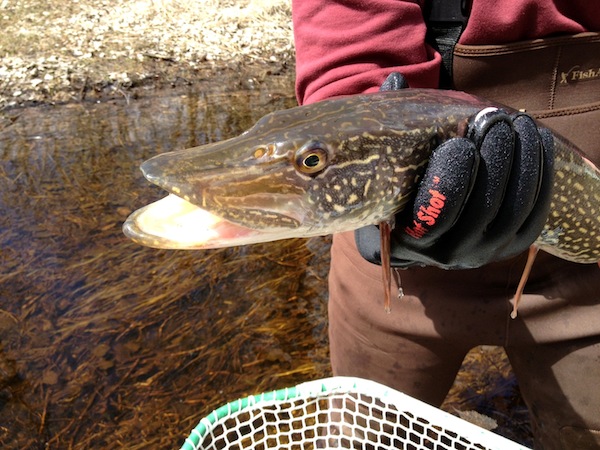Northern pike (Esox lucius) are one of many aquatic species that depend on healthy Great Lakes to thrive. (Image credit: Shedd Aquarium/Solomon David)
August brought challenging news for the Great Lakes. Researchers announced the expansion of a dead zone in Lake Michigan near Green Bay. Fed by phosphorus from agricultural and urban runoff, the dead zone at times covers 40 percent of the bay's freshwater estuary, creating an oxygen-deprived area that drives out aquatic life.
Estuaries are critically important nurseries for juvenile fishes and other animals, and dead zones in these waters can have a ripple effect across aquatic food webs, threatening not only native species but also the fishing and recreational industries that rely on healthy Great Lakes. One of the dead zone's primary sources, the Lower Fox River, is already on the USEPA's list of priority restoration projects under the Great Lakes Restoration Initiative (GLRI), but the dead zone's growth is a tough blow for these troubled waters. Thankfully Shedd Aquarium's Dr. Solomon David is in the field studying pike migrations which are basically smack in the middle of the dead zone and we're consulting with our partners at the University of Wisconsin-Green Bay about incorporating the dead zone topic into our current work.
Dead zones aren't the only Great Lakes issue in the news: Microplastics are another hot topic. These tiny bits of plastic come from many sources including industrial chemicals and some skin exfoliating products. Scientists are studying the role that microplastics might play in carrying pollutants through the Great Lakes, as well as whether fish mistake the round plastic beads for food; if so, the plastics potentially could work their way up the food chain to top predators--including us.
While the news can feel overwhelming, there are plenty of reasons for hope. As we learn more about the connections between humans and the Great Lakes, many people and companies are taking action to help our region's waterways. One thing you can do: turn your concerns into action and ask others to join you in protecting them. Because we care about the lakes, several companies have listened and are choosing to making a difference in reducing microplastic pollution: H2O+, Johnson & Johnson, Unilever, The Body Shop, L'Oreal and Colgate-Palmolive have publicly committed to phasing out the use of these ingredients. This is welcomed news for our lakes.
An ArcelorMittal volunteer collects trash from Chicago's 12th Street Beach during a Shedd-hosted Alliance for the Great Lakes Adopt-a-Beach event. (Image credit: Shedd Aquarium/Bill Beneventi)
To solve these basin-wide challenges, corporations, governments, and the public must continue to work together to create effective solutions, no matter how big or small, that transcend state and provincial boundaries. Look around our region, and you'll see many people engaged in such efforts. In Wisconsin, municipalities and farmers are partnering to test adaptive management strategies that could reduce phosphorus runoff and have a positive impact on dead zones. The states of Michigan and Ohio have teamed up to address the increased algae blooms that are plaguing Lake Erie. And closer to home, Shedd Aquarium works with the Chicago Park District, volunteers, and companies like ArcelorMittal, Coca-Cola, and others to keep plastic and other pollutants out of Lake Michigan through the Alliance for the Great Lakes' Adopt-A-Beach program.
This kind of work may not make the headlines, but it is happening all the time, everywhere in the Great Lakes.
These efforts should be inspiring, but we have much more work to do. We must keep pressing forward with partnerships that advance Great Lakes conservation, as well as creative programs that invite basin residents to develop their love for the lakes. Of course there are also things that we can do right now, like properly disposing of trash, choosing microplastic-free products, and keeping phosophorus runoff out of our local waters. If you're already taking lake-friendly actions, share them with me in the comments section.
Support HuffPost
Our 2024 Coverage Needs You
Your Loyalty Means The World To Us
At HuffPost, we believe that everyone needs high-quality journalism, but we understand that not everyone can afford to pay for expensive news subscriptions. That is why we are committed to providing deeply reported, carefully fact-checked news that is freely accessible to everyone.
Whether you come to HuffPost for updates on the 2024 presidential race, hard-hitting investigations into critical issues facing our country today, or trending stories that make you laugh, we appreciate you. The truth is, news costs money to produce, and we are proud that we have never put our stories behind an expensive paywall.
Would you join us to help keep our stories free for all? Your contribution of as little as $2 will go a long way.
Can't afford to donate? Support HuffPost by creating a free account and log in while you read.
As Americans head to the polls in 2024, the very future of our country is at stake. At HuffPost, we believe that a free press is critical to creating well-informed voters. That's why our journalism is free for everyone, even though other newsrooms retreat behind expensive paywalls.
Our journalists will continue to cover the twists and turns during this historic presidential election. With your help, we'll bring you hard-hitting investigations, well-researched analysis and timely takes you can't find elsewhere. Reporting in this current political climate is a responsibility we do not take lightly, and we thank you for your support.
Contribute as little as $2 to keep our news free for all.
Can't afford to donate? Support HuffPost by creating a free account and log in while you read.
Dear HuffPost Reader
Thank you for your past contribution to HuffPost. We are sincerely grateful for readers like you who help us ensure that we can keep our journalism free for everyone.
The stakes are high this year, and our 2024 coverage could use continued support. Would you consider becoming a regular HuffPost contributor?
Dear HuffPost Reader
Thank you for your past contribution to HuffPost. We are sincerely grateful for readers like you who help us ensure that we can keep our journalism free for everyone.
The stakes are high this year, and our 2024 coverage could use continued support. If circumstances have changed since you last contributed, we hope you’ll consider contributing to HuffPost once more.
Already contributed? Log in to hide these messages.

